‘February fill dyke’ has certainly lived up to its name but there are plenty of signs that winter is on its way out.
Bird song and activity have certainly increased recently. My local woodland echoed to the loud “yaffling” calls of a green woodpecker yesterday, a robin is bringing dry leaves to an old ivy-covered nest box outside my kitchen window and a mistle thrush has been singing from the very top of a neighbour’s tall tree.
Wild Update - February 2024
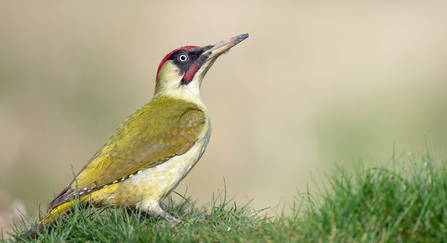
Green Woopecker
If you’ve never been yaffled at, listen here: XC876162 European Green Woodpecker (Picus viridis) :: xeno-canto
Rooks are noisily nest building at their rookeries and great crested grebes are displaying on lakes.
It's well worth taking time out to stop and marvel at these things which we sometimes take for granted.
Too-early insects
On February 15th, temperatures reached a crazy 17 degrees and so it was no wonder that some hibernating butterflies appeared.
15 brimstones were seen across the county that day along with smaller numbers of commas and peacocks.
Meanwhile, herald moths stayed in the cool depths of their caves and tunnels where they hibernate. 46 were counted in the old tramway tunnels at Ticknall Limeyards (once a DWT reserve) along with a few peacock butterflies.

Sleeping Herald moth by Sid Morris
Greenery and blossom
Leaves are bursting open both along verges, in woods on bushes and on climbers such as honeysuckle which is always very early. Wildflowers I’ve seen already include white dead nettle, dogs mercury, primrose, sweet violets and the tiny whitlow grass.
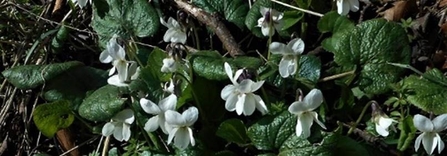
Sweet violet flowers come in either purple or white forms. Milldale 2023. NB
Powder puffers
Two British birds can be described as having white ‘powder puffs’ – the black grouse and the great bustard.
Male bustards display by turning their feathers inside out to show off their white plumage to advantage.
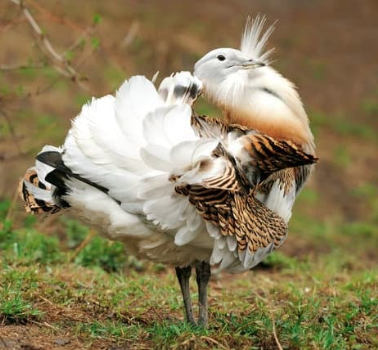
Great bustard
The last great bustard was shot on Salisbury Plain in 1849 but a private initiative to reintroduce these ‘bigger than a turkey’ birds has finally borne fruit and ‘wild’ birds now breed there each summer. Read about this bird here: Great Bustard Group . If you are ever down that way you can watch some from a hide as I have done.Having spent my teenage years on the edge of Salisbury Plain I am especially pleased that these magnificent birds are back.
In the Peak District, black grouse used to form their remarkable leks, ‘strut their stuff’ and display their white tail feathers in years gone by.
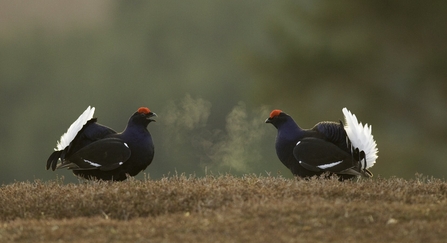
Black grouse Tetrao tetrix, two males leking, Scotland, April - Mark Hamblin/2020VISION
The last black grouse (blackcock) lek was at Swallow Moss just over the border in Staffordshire and I was privileged to see and hear it in the early 1980s just before it vanished. Male black grouse make wonderful hissing and gurgling noises as they pose on their lek. Hear the bubbling sounds of a lek on xeno canto: XC833645 Black Grouse (Lyrurus tetrix) :: xeno-canto
An attempt at reintroducing blackcock to Derbyshire was made some years ago but failed partly because the reintroduced birds immediately flew many miles away. Maybe the habitat wasn’t suitable or perhaps because their release wasn’t ‘soft’ enough, ie allowing them to slowly acclimatise before full release.
Unlike red grouse, blackcock need shrubby woodland as well as open moor. With plenty of new planting now taking place in the Peak, the time will soon be ripe for another more considered attempt to get this charismatic bird back. I can’t wait!
Red elves
Seeing those red wattles on the blackcock reminded me that I’ve received several reports of the scarlet elf cup fungus in the last week or two. I spotted it growing on a rotting stick by the High Peak Trail near Gotham at the weekend.
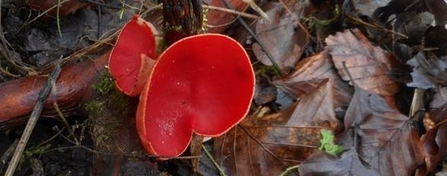
Bright elves glow amongst the leaf litter. NB
